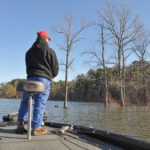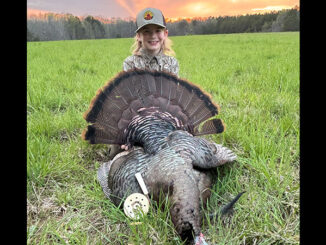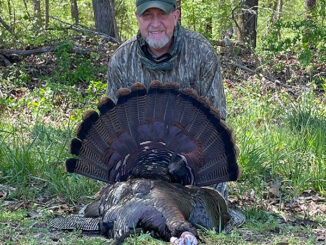
Largemouths at Kerr Reservoir are recovering from a bout with a deadly disease and offer new challenges to anglers.
By June, the best part of the bass-fishing year has faded into the rearview mirror.
February and March prespawn feeding frenzies have ended, and the April and May spawning orgy in the shallows is in the books. Male bass fertilized those eggs, then guarded bass fry floating in clouds near their birthplaces.
Bluegills will gobble up 99 percent of those tiny bucketmouths, especially in beds where sight-fishing anglers removed the guardian buck bass, leaving their tiny sons and daughters to fend for themselves.
Sight-fishing at beds will be a faint memory, except for the few stragglers of the micropterus salmoides clan whose internal clocks made them miss the bus to the spawning party.
But anglers still can catch bass, especially at 49,500-acre John H. Kerr Reservoir (aka Buggs Island), even though a bout of largemouth bass virus continues to work its way through the lake’s bass population.
“June is a postspawn, transition month at Buggs,” said guide Tim Wilson of Buffalo Junction, Va., near the lake’s Grassy Creek arm.
While April and May are good months for shallow-water fishing, anglers will have to adjust their techniques in June, he said.
“In the first part of the month, bass fishing won’t be too different from the spawn, although it may be a lot different this year because we’ve had such a mild winter and much warmer temperatures,” Wilson said.
He said bank beaters still will have a chance because of the late spawners, but more likely because of the herring/alewife spawn.
“The beginning of June is when herring spawn,” said the 47-year-old Wilson, who has been guiding at Kerr since 2000. “They like clay banks, and you can catch them with topwater lures early and late in the day.”
The lake, as most visiting anglers know, has miles of steep red clay banks, particularly on either side of its two main arms: the 17-mile section that runs east to west from the dam and the Nutbush Creek arm that extends north to south 15 ½ miles from the dam.
“I like to fish Nutbush in June, then up to around North Bend (Park), and Eastland (Creek) can be good,” said Wilson, whose favorite early morning June topwaters are Zara Spooks, Spook Pups and Lucky Craft Sammys.
“If the topwater bite is over that day, I also like to throw a jerkbait or a Zoom Fluke,” he said.
One of his favorite spots includes the islands at the mouths of several coves along the eastern side of Nutbush Creek.
Durham’s Doyle Hodgin, a bass pro and lure maker, once filmed a TV show during June around these islands along the eastern shore of Nutbush from County Line Recreation Area south to Burroughs Mill Branch. He threw an in-line Front Runner, trailed about two feet by a Chug Bug or Pop-R. His cameraman caught Hodgin landing multiple doubles near these islands.
Wilson said he’s aware of the island topwater bite in Nutbush during June.
“It’s the herring spawn at those islands,” he said. “The herring spawn, and the bass line up to eat them, and you can really work on them with a topwater lure. You can catch them with any type of walking bait, such as a (Zara) Spook, too.
“Up near the dam on (Kimball Point), you can catch them the same way because the herring will be up there, also.”
The topwater bite usually ends around 10 a.m.— anglers can catch bass longer with topwater lures if it’s cloudy — Wilson targets submerged structure with deep-diving crankbaits or Carolina-rigged plastic lizards or worms.
“That’s where the bass go, especially if the water’s warm, after about 10 o’clock most days in June,” Wilson said. “They like to get away from the surface and get down where the water’s a little more to their liking.”
During the late morning and afternoon, he may target creek drop-offs, rocks and stumps from 12 to 20 feet deep.
“I’ve got Fat Free Shads, the big ones, that I like to cast at deep structure,” said Wilson, who removes the hooks that come on the baits and replaces them with 2/0 to 4/0 wide-gap Gamakatsus. “If they’re not biting the Fat Free Shad, I’ll change to Carolina-rigging worms.”
“I normally keep my boat in deep water and throw toward the structure,” he said. “If it’s a ledge or a rockpile and they’re not hitting the crankbaits, I’ll change to a Carolina rig with a 6-inch Zoom lizard in pumpkin-chartreuse color.”
Wilson said he’s also started using bigger worms to catch bigger fish.
“I like the Zoom Ol’ Monster worms, Texas-rigging them around brush or at road beds,” he said. “The best structures at the lake are road beds and sunken bridges.”
In early June when main-lake water still may be stained, Wilson remains in the Nutbush arm because it’s clearer — its waters seined by aquatic grasses.
“There seems to be more grass in the Nutbush section,” he said. “It may be because the water’s a little shallower in the creeks and grass has an easier time gaining a foothold.”
Wilson also said this vegetation creates excellent hiding places for baitfish, which in turn attract bass.
“If fish are still shallow in early summer, a buzzbait or Sammy resembles a herring,” he said. “Swimbaits obviously also look like herring.”
Wilson likes to cast a BassTrix 6-inch swimbait threaded onto a leadhead jig bearing the name of Denny Gilbert, a tournament angler from nearby Napoli, Va.
But by the middle of June, conditions change as the water temperature climbs toward the 80-degree mark and higher.
“What happens after the spawn is finished for herring, they move out into the middle of the lake,” Wilson said. “This is a major change from the past when you could Carolina-rig soft plastics off points dropping into deep water or work ledges.
“Now the largemouths act almost like striped bass and chase herring in open water. Bass don’t follow structure any more in the summer at Buggs; they follow herring.”
Late-June fishing takes on an entirely different dimension as anglers have to watch their depth finders for telltale signs of herring — and know how to identify them.
Threadfin or gizzard shad appear as clouds on a depth finder. By June they will run from 15 to 25 feet below the surface.
Not so for herring.
“The herring move out into the middle of Nutbush during the summer,” said Wilson, who caught 5- and 6-pound bass chasing herring “in the middle of Nutbush” last summer. “So that’s where you have to go to find them.”
For topwater fishing, Wilson likes 7-foot Lew’s rods for the long casts needed, plus Lew’s reels with a slow, 5-to-1 retrieve ratio, plus braided line that doesn’t have the elasticity of monofilament.
“You want something that will set a hook immediately when you feel the fish,” he said. “You don’t want any give in the line or a bass will shake his head and put slack in the line, and that makes it easier to throw a hook.”
Wilson casts swimbaits at schooling herring in open water, hoping to catch bass lurking underneath.
When largemouths are in shallower water and Wilson fishes structure — around islands, for example — he spools 10-pound-test P-Line on his main reel.
“I tie my lures directly to my line,” he said. “I don’t use fluorocarbon or leaders.”
However, when he’s fishing his Carolina-rigged soft-plastic lures around deep structure, he uses monofilament and a mono leader in case a lure gets hung tight on the bottom.
“I can break leader line in that case,” he said.
Wilson said bass are overcoming the largemouth bass virus that infested fish several years ago, so he sees better days ahead.
“The lake’s getting better,” Wilson said. “It’s got a lot of 4- to 6-pounders in it.”
DESTINATION INFORMATION
HOW TO GET THERE/WHEN TO GO: Bass fishing is excellent on Kerr Lake (Buggs Island), in May, June and July. Fish around islands or clay banks where blueback herrig are spawning. Look for herring schooling near the surface in open water later in the day and later in the month. Kerr/Buggs Island rides the North Carolina-Virginia border north of Henderson. For the area around the dam and Nutbush Creek, Satterwhite Point, Bullocksville and County Line landings are easily accessible from I-85. To fish up the lake, take NC 39 north through Oxford to Clarksville, Va., or NC 15 north off I-85 to Townsville.
TECHNIQUES/TACKLE: Use topwater lures during early morning and evening hours in the Nutbush Creek arm of Kerr Lake, especially near islands on the eastern shore where blueback herring spawn. Alsos try jerkbaist and swimbaits. When bass go deep later in day, try ledges, drop-offs, rocks and stump fields with big Carolina-rigged soft-plastics. Medium-action baitcasting or spinning outfits are best, with long rods preferred for long casts. Reels should be spooled with 10- to 15-pound braided line for topwaters, 15-pound mono with 10-pound mono leader for Carolina rigs.
GUIDES/FISHING INFO: Tim Wilson, Tim’s Guide Service, 434-374-0674 or www.kerrlake.com/timguide/index.htm; Joel Richardson, Joel Richardson Guide Service, 336-803-2195 or www.joelgrichardson.com. See also GUIDES & CHARTERS in Classifieds.
ACCOMMODATIONS: Many motels For motels on the lower end of the lake near Henderson, contact the Vance County Department of Tourism, 866-438-4565 or www.kerrlake-nc.com. For lodging near Clarksville., Va., up the lake, Best Western-On The Lake, 434-347-5023 or www.bestwesternvirginia.com or Lake Motel & Efficiences, 434-374-8106 or www.conradusa.com. The U.S. Army Corps of Engineers operates 29 campgrounds scattered around the lake’s shoreline. Call 434-738-6101.
MAPS: FHS Maps, 800-ALL-MAPS or www.fishinghotspots.com; GMCO Maps, 888-420-6277 or www.gmcomaps.com; Kingfisherm maps, 800-326-0257 or www.kfmaps.com.









Be the first to comment